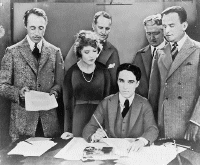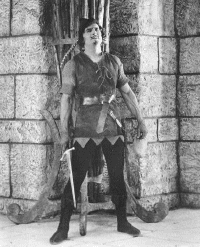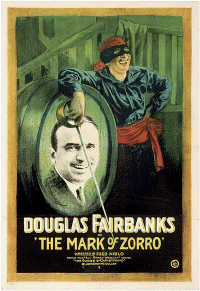 SKC Films Library |
| SKC Films Library >> Dramatic Arts >> Biography: United States |
| Douglas Fairbanks "everybody's hero"
Douglas Elton Ullman was born in Denver, Colorado, on May 23, 1883, the second of two sons born to Hezekiah Charles Ullman and Ella Adelaide Marsh; he also had a half-brother, John Fairbanks, Jr., from his mother's first husband, John Fairbanks (who had died of tuberculosis). His father, an attorney, left the family when Douglas was five, and his mother retook her first husband's last name. Fairbanks began acting in amateur theater at the age of 12, and was often disciplined as a student at East Denver High School for "acting in class." Moving to New York City in 1900, he worked on a cattle freighter, in a hardware store, and as a clerk on Wall Street before making his Broadway debut, in 1902. On July 11, 1907, Fairbanks married Anna Beth Sully, the daughter of a wealthy industrialist, and he quit the theater soon after; he returned to the stage in order to earn an income within a year, however, after Anna's family went bamrupt. Their son, Douglas Fairbanks, Jr. was born in 1909 (Douglas Jr. would grow up to become an actor in his own right). In 1915, Fairbanks made the move to Hollywood, where he was hired by Triangle Pictures. It was at this time that he began working with D.W. Griffith, who was initially unimpressed with his new young actor. He formed the Douglas Fairbanks Film Corporation in 1916, and was hired by Paramount Pictures soon after. Despite Griffith's initial disappointment with him, Fairbanks was the third highest paid actor in Hollywood by 1918. "Everybody's hero" met "America's sweetheart" Mary Pickford in 1916, while the two were touring the country on a World War One Liberty Bond tour. The two began seeing each other romantically almost immediately, even though both were married (she to Owen Moore). Had the two not been so popular with the American public the adulterous relationship would have been considered scandalous and their respective studios would likely have nixed the romance immediately, but their popularity overshone the scandal and the general public thought it was a natural romance. After divorcing their respective spouses, the two were married on March 28, 1920, and they took up residence in a Hollywood mansion they dubbed "Pickfair." In 1919, Fairbanks, Pickford, Griffith, and Charlie Chaplin formed United Artists Corporation so they could have more control over their projects and earnings. The company was kept solvent in the years immediately after its formation largely from the success of Fairbanks's films. In 1921, he, Pickford, Chaplin, and others, helped to organize the Motion Picture Fund to assist those in the industry who could not work and/or were unable to meet their bills. the creation of United Artists By 1920, Fairbanks had completed twenty-nine films (twenty-eight features and one two-reel short). In that year's The Mark of Zorro, Fairbanks combined his appealing screen persona with a new adventurous costume element. The movie was a smash success, and for the remainder of his career in silent films he continued to produce and star in ever more elaborate, impressive costume films, such as The Three Musketeers (1921), Robin Hood (1922), The Thief of Bagdad (1924), The Black Pirate (1926, the first full-length Technicolor film), and The Gaucho (1927). Douglas Fairbanks as Robin Hood playbill for The Mark of Zorro During the first ceremony of its type, on April 30, 1927, Fairbanks and Pickford placed their hand and foot prints in wet cement at the newly opened Grauman's Chinese Theatre in Hollywood. One of the 36 founders of the Academy of Motion Picture Arts and Sciences (AMPAS), Fairbanks served as its first president until 1929, and he presented the first Academy Awards at the Roosevelt Hotel (alongside William C. de Mille). Fairbanks's last silent film was the lavish The Iron Mask (1929), a sequel to 1921's The Three Musketeers, which included an introductory prologue spoken by Fairbanks. He and Pickford chose to make their first talkie as a joint venture, playing Petruchio and Kate in Shakespeare's The Taming of the Shrew (1929). This film, and his subsequent sound films, were poorly received by Depression era audiences, however. The last film he acted in was the British production The Private Life of Don Juan (1934), and he retired from acting soon after. Fairbanks and Pickford were divorced on January 10, 1936, and Fairbanks married Lady Sylvia Ashley (with whom had been having an affair) in March of that same year; Pickford kept Pickfair. Douglas Fairbanks died suddenly of a heart attack on December 12, 1939, in Santa Monica, California. His funeral service was held at the Wee Kirk o' the Heather Church in Glendale's Forest Lawn Memorial Park Cemetery, where he was placed in a crypt in the Great Mausoleum. Later that month, he was awarded a posthumous Oscar "recognizing the unique and outstanding contribution of the first President of the Academy to the international development of the motion picture." In 1941, Sylvia Fairbanks commissioned an elaborate marble tomb and monument for him in Hollywood Memorial Cemetery (now Hollywood Forever). The monument was dedicated in a ceremony held in October 1941, with Charlie Chaplin reading a remembrance. Filmography Silents The Lamb (1915) "Talkies" The Taming of the Shrew (1929) SOURCES SEE ALSO |
| SKC Films Library >> Dramatic Arts >> Biography:
United States This page was last updated on 06/29/2018. |



